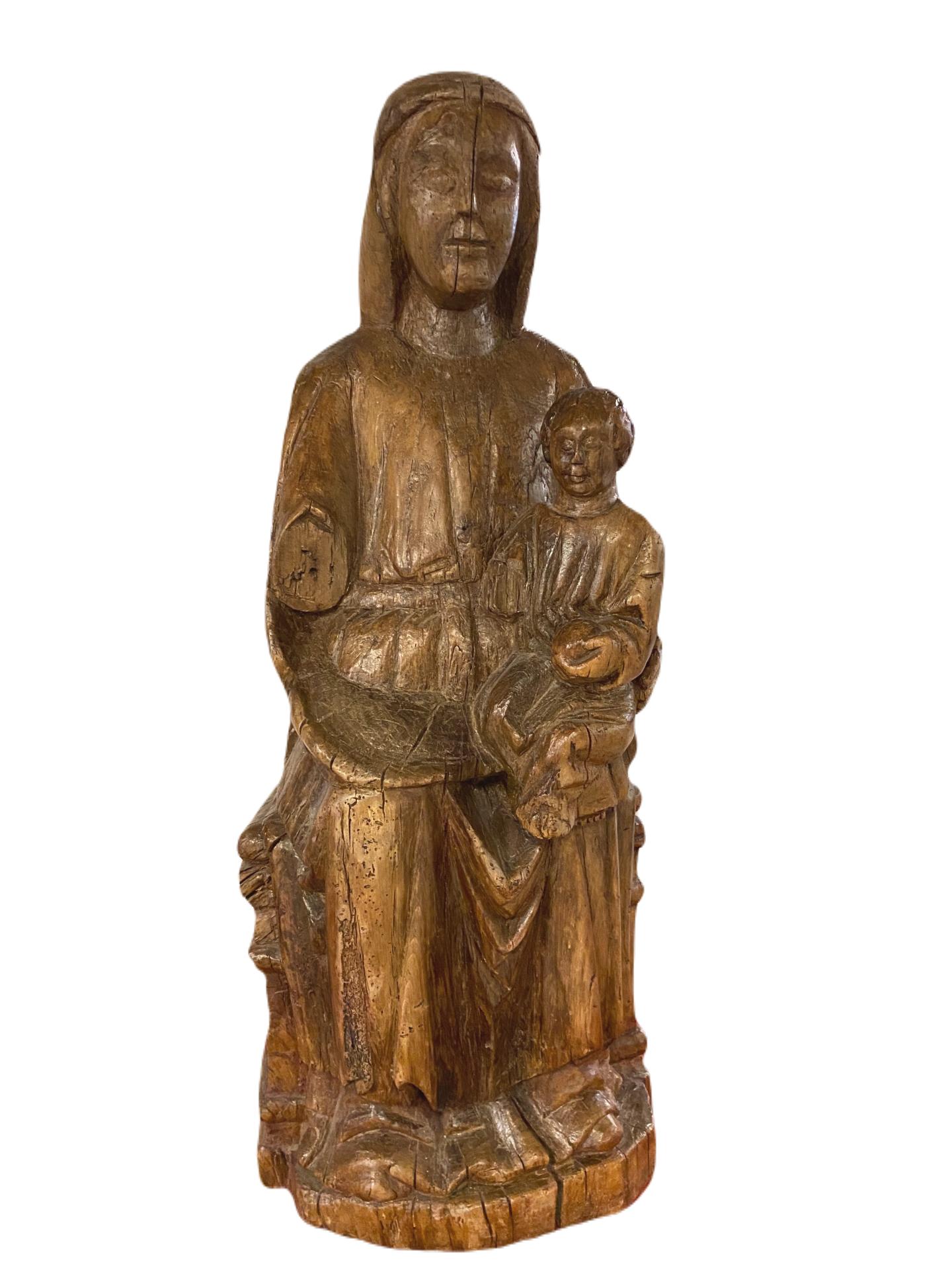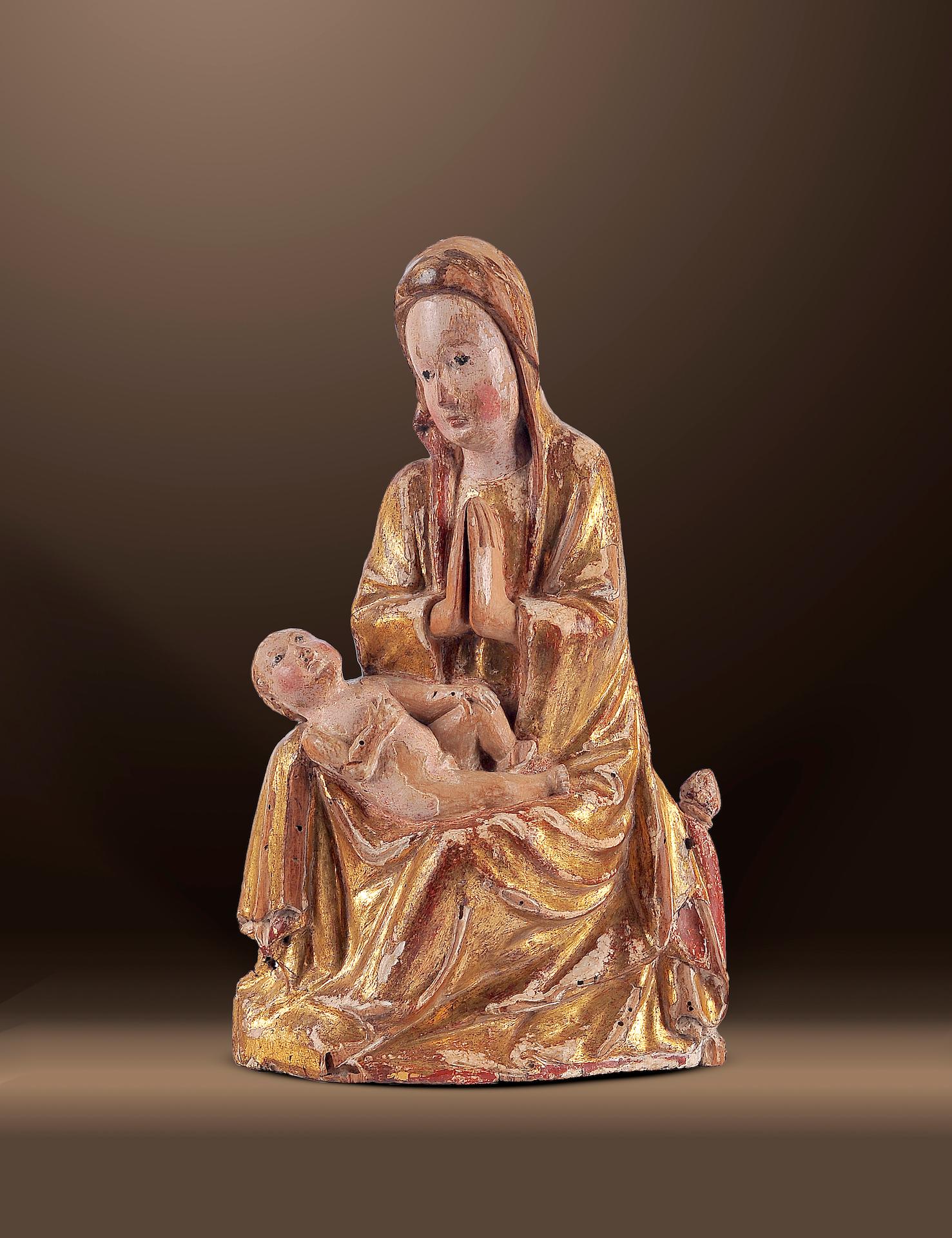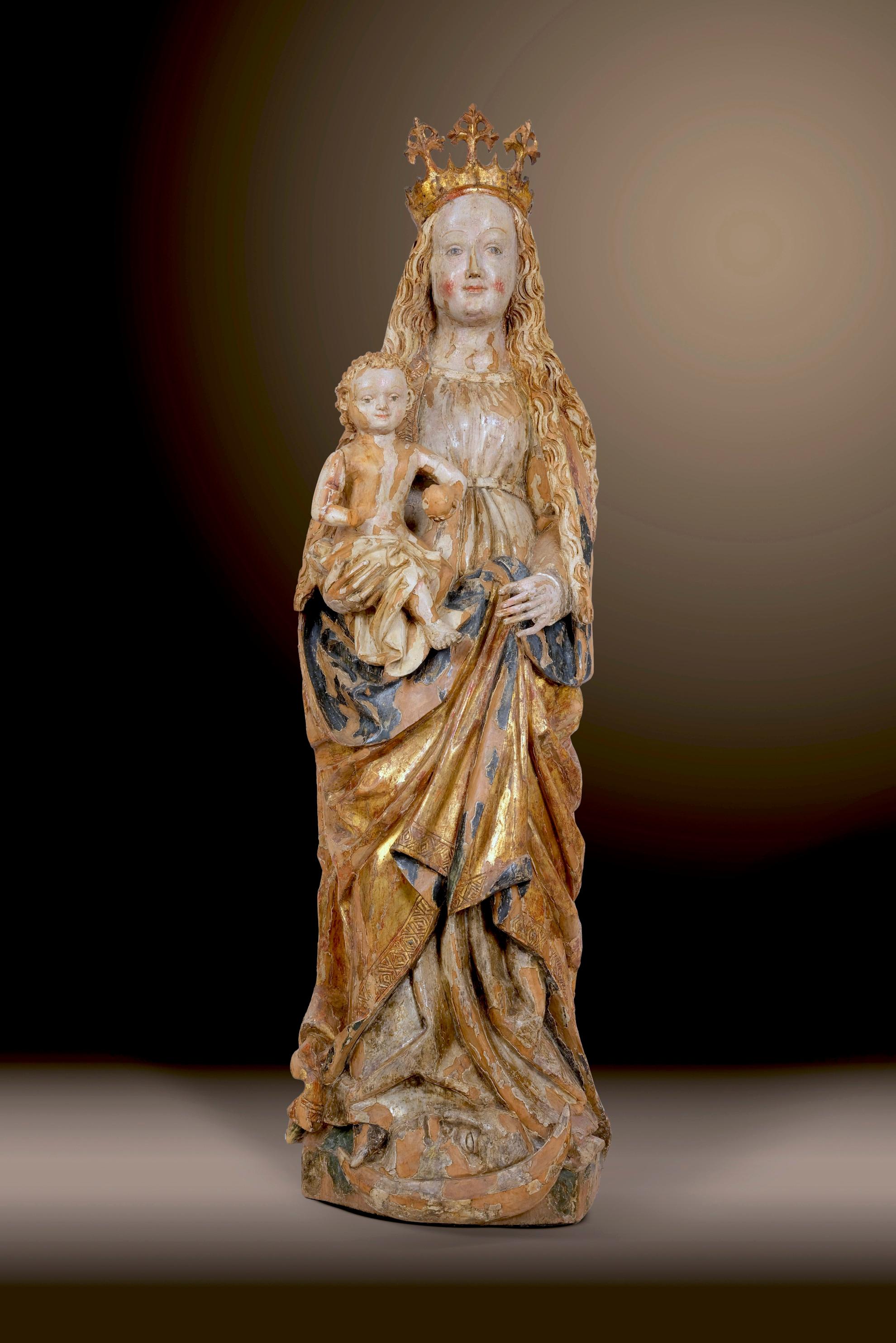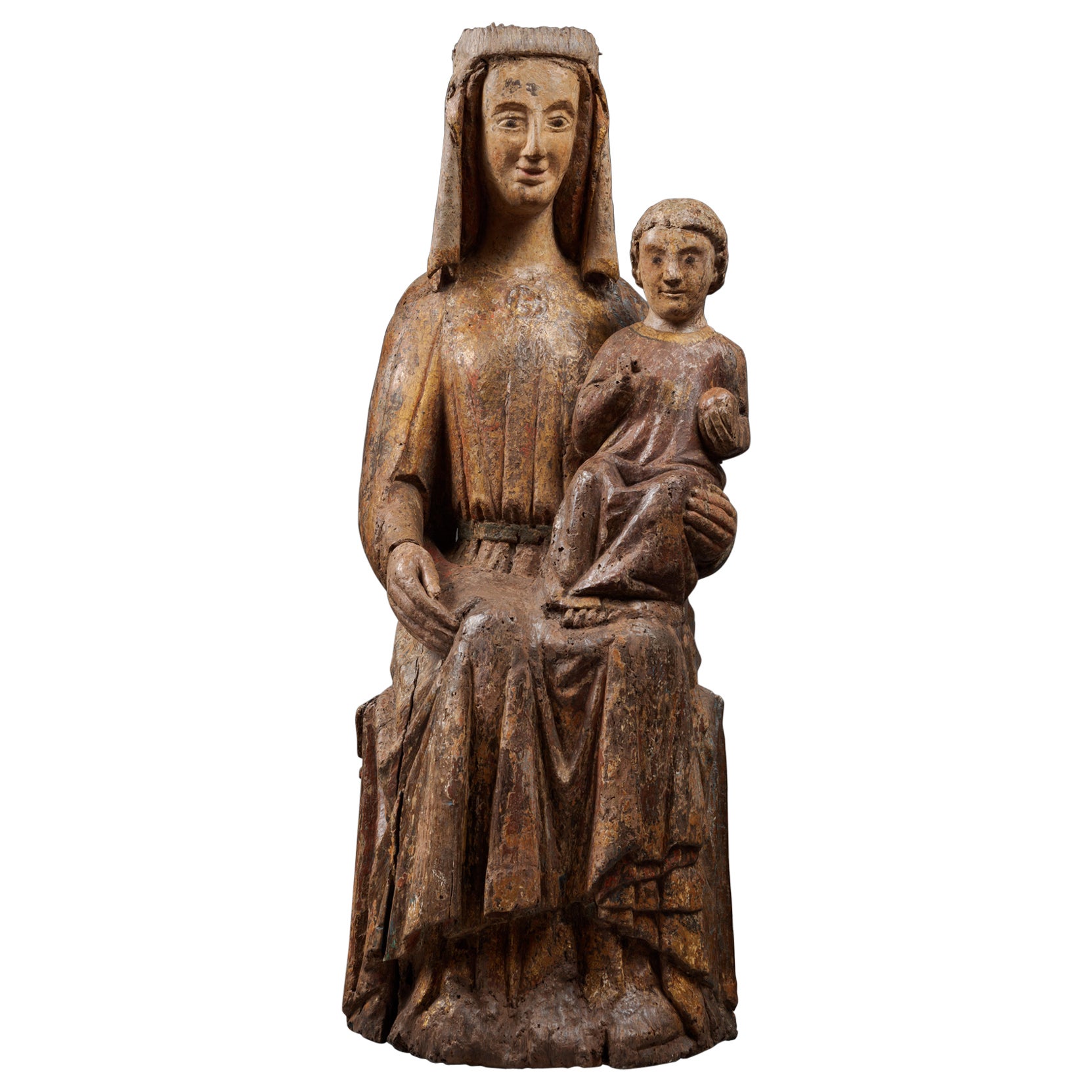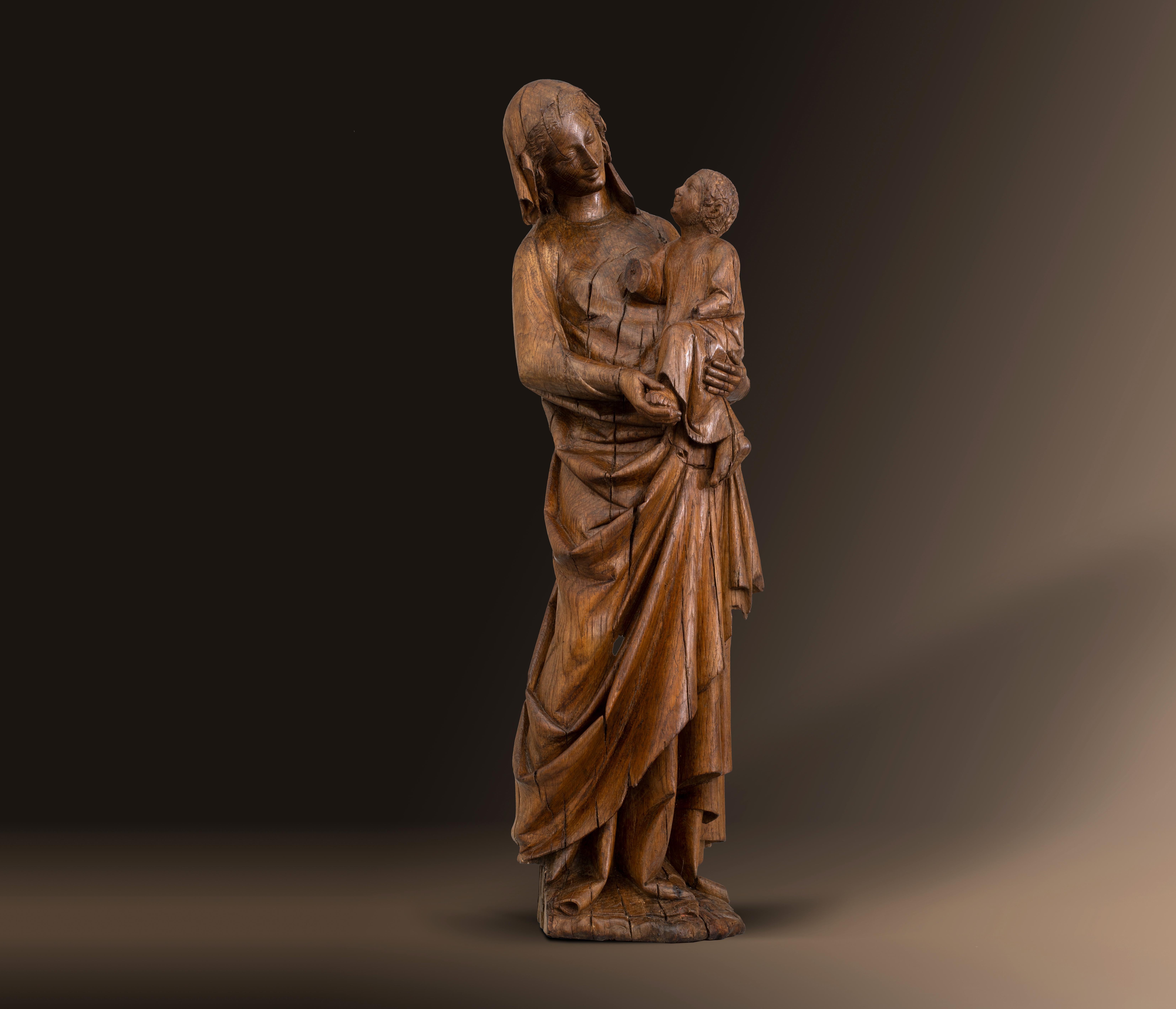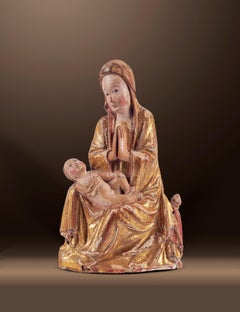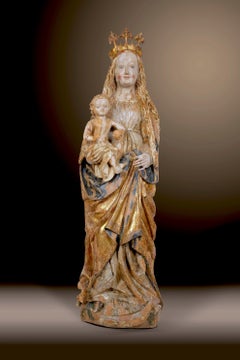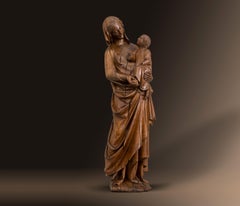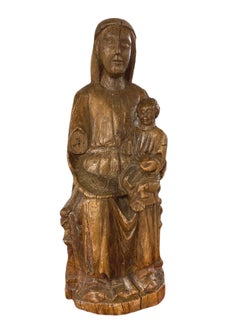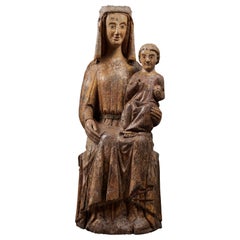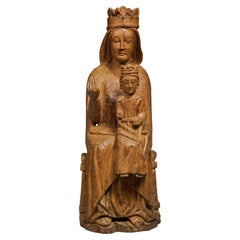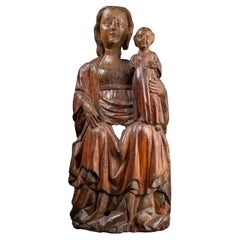Items Similar to Romanesque Madonna - 1175/80
Want more images or videos?
Request additional images or videos from the seller
1 of 11
UnknownRomanesque Madonna - 1175/801175/80
1175/80
$120,000
£90,511.01
€104,541.11
CA$168,128.27
A$186,948.99
CHF 97,871.16
MX$2,283,616.80
NOK 1,229,847.66
SEK 1,156,918.19
DKK 780,392.17
About the Item
ROMAN MADONNA
“Sedes Sapientiae”
Auvergne
Around 1175/80
Pine wood
Polychrome remains
Height 40 cm
This depiction of the Madonna is a masterfully carved, extremely early figure made of pine or stone pine wood in an exquisite state of preservation. It was made in the French Auvergne around 1175. The compact size (40 cm) as well as the high quality indicate its production for the precious altar shrine of a Romanesque church.
The Madonna corresponds to the Sedes Sapientiae type: Mary as the throne of divine wisdom. She is seated on a magnificently carved two-tiered raised throne and enthroned in the center is the infant Jesus on her lap, facing frontally as is his mother. In the left hand it holds a book, while it has raised the right hand in the proclamation gesture. The figure is symmetrically constructed; the meticulous frontality clearly shows the early period of this impressive depiction. The faces are vividly expressively carved, with large, wide-open eyes and deeply notched upper eyelids. The stern expression is accentuated by the prominent nose, which seamlessly blends into the sharp ridges of the eyebrows. Mary’s full lips are slightly open, while those of the child are pursed. A reference to Mary’s role as mediator, communicating with people and, as a result, delivering their intercessions to Jesus?
The carefully crafted surfaces suggest the drapery folds only in shallow relief, typical of the 12th century period. Mary’s veil cloth is laid smoothly over her head, with indentations on the underside. In these places were probably appliqués – possibly precious stones. The folds are bulging around her forearms; on the upper body, rounded incised marks indicate an attempt to depict a thin robe. This falls in idiosyncratic configurations around the smooth kneecaps to hit the ground in parallel fashion. Here the textile appears thick like luxurious brocade fabric; a supposedly dense border falls between Mary’s feet as the only asymmetrical element in suggested zigzag folds. The doughy-soft folds over the rounded forms seem like the transfer of a two-dimensional painting technique to the three-dimensional carved object. Especially icon depictions of Byzantine chrysographic technique and enamel work are recalled here.
Traces of polychromy have survived in the notched grooves, indicating that the Madonna’s robe was dyed green and her cloak blue. Light red traces of color on the child’s dress refer to its red coloring, and in the tradition of Christian color symbolism this could refer to the imminent Passion of Christ. However, it could also be bolus – an alumina silicate – that serves as a substrate for later gold leaf gilding. The throne is covered with remnants of a dark, oxidized layer, indicating earlier silver plating. This is also symmetrically structured: A group of three narrow columns, each ending in arcaded arches, flanks the depiction of the Madonna in a majestic manner. These arcades each support a panel with an elliptical decorative ornament inscribed in a thick rectangular frame. The reference to contemporary luxurious furniture is also found in more of these early Madonna depictions.
For example, the so-called Madonna of Orcival, or Vierge en Majesté, is stylistically very related to the specimen presented here. Both testify to high, masterful quality, although the sculpture described is characterized by greater elegance and was constructed in a less block-like, rigid manner. The child’s bent-over posture proves this in a playful manner and also makes the depiction seem more viewer-oriented. Furthermore, it is already part of the later typical tradition of not merely gilding the bodies of the figures, as in the beginning, but also dressing them in appealingly colorful polychrome.
- Creation Year:1175/80
- Dimensions:Height: 15.75 in (40 cm)Width: 7.88 in (20 cm)
- Medium:
- Movement & Style:
- Period:
- Condition:Very good condition for the age.
- Gallery Location:Wien, AT
- Reference Number:1stDibs: LU114326678962
About the Seller
No Reviews Yet
Vetted Professional Seller
Every seller passes strict standards for authenticity and reliability
Established in 1986
1stDibs seller since 2019
- ShippingRetrieving quote...Shipping from: Wien, Austria
- Return Policy
Authenticity Guarantee
In the unlikely event there’s an issue with an item’s authenticity, contact us within 1 year for a full refund. DetailsMoney-Back Guarantee
If your item is not as described, is damaged in transit, or does not arrive, contact us within 7 days for a full refund. Details24-Hour Cancellation
You have a 24-hour grace period in which to reconsider your purchase, with no questions asked.Vetted Professional Sellers
Our world-class sellers must adhere to strict standards for service and quality, maintaining the integrity of our listings.Price-Match Guarantee
If you find that a seller listed the same item for a lower price elsewhere, we’ll match it.Trusted Global Delivery
Our best-in-class carrier network provides specialized shipping options worldwide, including custom delivery.More From This Seller
View AllSitting Madonna
Located in Wien, Wien
Sitting Madonna
Central Italy/Tuscany or Marche
Around 1420
Poplar wood carved
Original version
Height 31 cm
Charming Madonna sculpture from the heyday of the Soft or International...
Category
15th Century and Earlier Gothic Figurative Sculptures
Materials
Wood
Virgin and Child
Located in Wien, Wien
OUTSTANDING MADONNA
Bavaria
Around 1515/20
Lime wood carved
Original, polychrome version
Height 60 cm
This masterfully carved, full-round Madonna was created around 1515-20 in...
Category
16th Century Medieval Figurative Sculptures
Materials
Wood
CRESCENT MOON MADONNA
Located in Wien, Wien
Master in the circle of Michael Pacher
(Mühlen ca. 1435 - 1498 Salzburg)
Salzburg
Around 1480
Carved limewood
Old polychrome version
Height 118 cm
This Madonna is an outstanding ex...
Category
15th Century and Earlier Gothic Figurative Sculptures
Materials
Wood
$168,000
Madonna
Located in Wien, Wien
MADONNA
Il DE FRANCE/PARIS
Around 1270
Oak wood carved
Height 79cm
Category
15th Century and Earlier Figurative Sculptures
Materials
Oak
Price Upon Request
Madonna
Located in Wien, Wien
MUSEUM SCULPTURE
Master workshop
Hans Klocker
before 1474, possibly in Gais -
After 1500
"CRESCENT MOON"
Around 1480/90
Stone pine wood carved
Original version
Height 77 cm
This ext...
Category
15th Century and Earlier Figurative Sculptures
Materials
Wood
Price Upon Request
Sedes Sapientiae
Located in Wien, Wien
Sedes Sapientiae
Pustertal um 1220/30
Weichholz/Lindenholz(?)geschnitzt
Reste von originaler Polychromie
Höhe 57 cm
Category
15th Century and Earlier Figurative Sculptures
Materials
Wood
You May Also Like
Enthroned Madonna and Child.
Located in PARIS, FR
Large Virgin and Child in carved wood, carved back. Sitting on a throne bench, Mary carries Christ seated on her left knee. The Virgin has a face with stylized features with semicircular eyebrow arches, almond-shaped eyes with protruding eyeballs. Marie is wearing a belted dress with a simple neckline and a coat with a flap that goes back to the front. Tiny traces of polychromy.
Romanesque influences are still present. With her protruding eyes, she can also be compared to the statuary of Lake Constance. Our Virgin, rare for its size, nevertheless presents strong analogies with the Italian Sedes Sapientiae...
Category
15th Century and Earlier Medieval Figurative Sculptures
Materials
Wood
Important Virgin and Child in Majesty
Located in Saint-Ouen, FR
Important virgin and child in majesty
Origin : Germany Or Eastern France
Époque : Second Half Of The 13th Century
Height: 104.5 cm
Length: 3...
Category
Antique 15th Century and Earlier Figurative Sculptures
Materials
Oak
Virgin and Child in Majesty, also known as "Sedes Sapientae"
Located in Saint-Ouen, FR
VIRGIN AND CHILD IN MAJESTY, ALSO KNOWN AS "SEDES SAPIENTIAE"
ORIGIN : SPAIN, CATALOGNE
PERIOD: EARLY 13th CENTURY
Height : 95 cm
Width : 32 cm
Depth : 28 cm
Softwood
No polychromy
In the middle of the 12th century, the Virgin took her place in churches, seated in Majesty, serving as a throne for her son Jesus. She is then called Sedes Sapientiae, meaning the Throne of Wisdom.
At that time, she is not represented for herself and only exists because she has been designated as Theotokos, the mother of God, at the Council of Ephesus in 431, where the divine nature of Christ was proclaimed from his birth.
The upright and perfectly hieratic bust of this Virgin and Child in Majesty is seated on a throne-bench. She is dressed in a tunic with a rounded neckline and covered with a fine mantle placed on her narrow shoulders. The supple and natural drapery follows the lines of the body.
Large curls frame her face with delicate and regular features, a long straight nose, almond-shaped eyes, and small lips.
She supports the Infant Jesus with her left hand. Like his mother, he is dressed in a long tunic, and his little feet are visible in the folds. He holds a small sphere in his left hand, while with his right hand, he gestures in blessing. The face of Christ bears a strong resemblance to his mother’s one, and he gives a slight smile.
The position of the Child is no longer as hieratic, nor frontal or central as in the early 12th century, but his face still turns towards the faithful.
The 13th century indeed emerges as a period of transition in the artistic domain. The statuary, while retaining certain characteristics still belonging to the habits of the previous century, also develops new formal solutions.
As a result, Mary maintains a hieratic and frontal position, while her son shifts to place himself well to the left on her knee. Similarly, while the Virgin seems perfectly still, Jesus, on the other hand, appears much more animated, especially in the positioning of his hands. His left hand holds the orb, and judging by the raised right arm directed towards the faithful, one can easily imagine that he was making a gesture of blessing.
The influence of the Sedes Sapientiae from previous centuries still seems particularly prevalent in this work.
These few characteristics allow dating this Spanish Virgin...
Category
Antique 15th Century and Earlier Spanish Gothic Figurative Sculptures
Materials
Softwood
Virgin and the Child, Mosan Region, Second Half of 13th Century
Located in Bruxelles, BE
A polychrome sculpture depicting the Virgin and the Child
Mosan region, second half of 13th century
Polychrome wood
73 x 29 X 12 cm
Provenance :
Former Belgian private collection from the beginning of the 20th century
This remarkable early artwork portrays the Enthroned Virgin and Child, also known as Sedes Sapientiae, which translates to the 'Seat of Wisdom...
Category
Antique 15th Century and Earlier Belgian Medieval Figurative Sculptures
Materials
Wood
Virgin and Child in Majesty with a Bird
Located in Saint-Ouen, FR
Virgin and child in majesty with a bird
Origin: Southern Germany Or Austria
Period: Late 13tth - Early 14th Century
Height : 87.5 cm
Length : 32 cm
Depth : 19 cm
Lime ...
Category
Antique 15th Century and Earlier Figurative Sculptures
Materials
Wood
Vierge en majesté mosane. Sedes Sapientiae.
Located in PARIS, FR
Grande Vierge à l'Enfant en chêne de la fin du 13ème siècle ou début du 14ème siècle. La plastique des visages et du Christ évoque le 13ème siècle (le visage de la Vierge évoque le visage de la Sedes Sapientiae...
Category
15th Century and Earlier Gothic Figurative Sculptures
Materials
Wood
More Ways To Browse
15th Century Stone Sculpture
Roman Wood Sculptures
Relief Sculpture Face
Antique Jesus Sculpture
Jesus Wood Sculpture
Jesus Christ Sculpture
Gothic Wood Sculpture
Stone Altar
Silver Throne
Roman Altar
Antique Brocade Fabric
Jesus Child Sculpture
15th Century Polychrome Sculpture
Antique Purse Frames
Altar Shrine
Blue Brocade Dress
Antique Enamel Compact
Enamel Silver Compact
